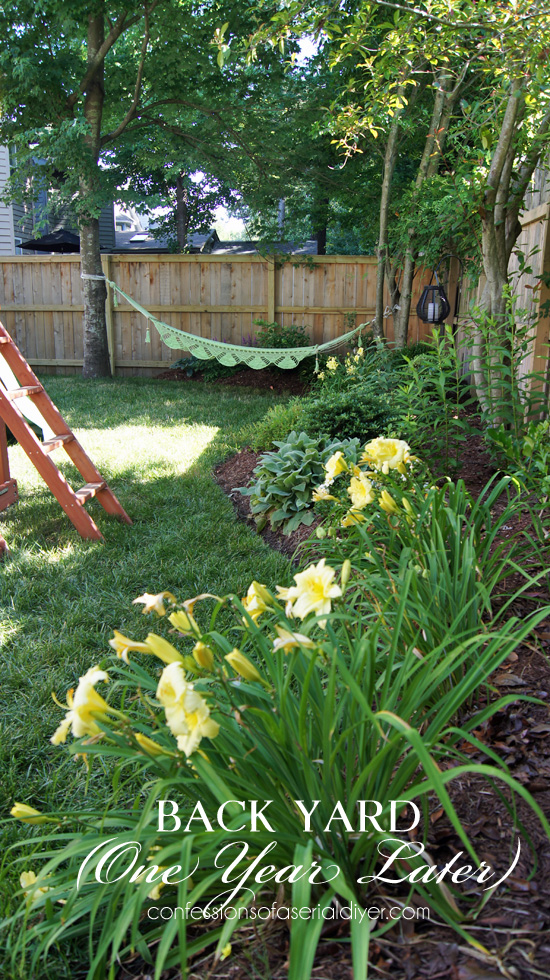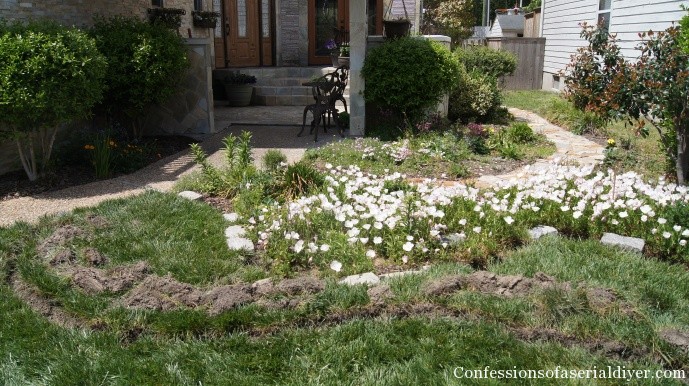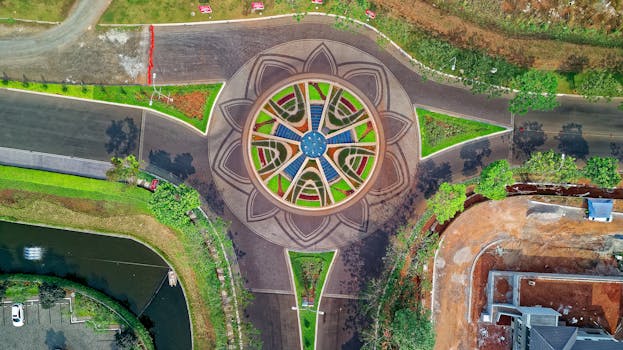I have really enjoyed sharing my landscaping makeovers and hearing all of the awesome feedback. It was a lot of hard work that is really paying off. I love my outdoor space. I have been asked several questions about my makeovers with the most frequent one being, “How did I know what plants to buy?”
First I am going to share with you how I came up with my landscape plan and the work that went into creating my planting beds. After all, you can’t plant anything until the beds are ready, right?
I could easily break this into several posts about each and every step, but I know if I were planning an outdoor redo, I wouldn’t want to have to wait around for post after post. So here we go! Let me start by saying, I am in no way an expert! My suggestions are based solely on my experience and what I have learned along the way. Before we get started, if you haven’t seen any of my landscaping makeovers, here are the most recent updates.
Back Yard Makeover (One Year Later)
Front Yard Makeover (One Year Later)
Visit the original Back Yard Makeover reveal here.
Visit the original Front Yard Makeover here.
Visit the Side Yard transformation and granite block patio reveal here.
How do I know where to even begin changing my landscape?
The best way to create a plan for your landscape is to draw it out on graph paper. Draw the outline of your home. This will require some measuring. Each square on your paper = one square foot of space. Then draw the outline of your outdoor space. You may want to make copies now so you’ll have a clean sketch to go back to.
It is important to get your drawing as close to scale as possible because you will use this drawing to determine spacing for your plants later.
Add any bushes or trees that will be staying as well as any hard surfaces such as paths, driveway, etc. Now play with it. Pencil in different ideas. Don’t like it? Erase it and start again. I changed my mind several times on paper before I came up with a layout I liked. Even if you are redoing a small area. Draw it out. This will help you visualize the finished space. Here is the front border garden as I drew it out on paper:  Don’t be afraid to go big! No area should be less than four feet in diameter. I am barely pushing it along the property line there. I would have made that wider if I could, but I have such a small patch of grass as it is. If it’s too narrow, your garden won’t have any depth. If you are planning on adding any hard scape, pathways, etc such as our flagstone pathway below, that should be done first!
Don’t be afraid to go big! No area should be less than four feet in diameter. I am barely pushing it along the property line there. I would have made that wider if I could, but I have such a small patch of grass as it is. If it’s too narrow, your garden won’t have any depth. If you are planning on adding any hard scape, pathways, etc such as our flagstone pathway below, that should be done first!
What is the best way to create my planting beds?
Once I determined how I was going to lay out my new landscape, I used flour to mark where my planting beds would go. This made it easy to change it if needed. *Don’t forget to call the underground utility company(s) to come out and mark their lines before you dig! (Thanks, Jackie!) Then I used a flat shovel and created a trench all around the outside edge. In this picture, you can see the initial cuts. I actually went back a second time to make them twice as wide as you see here. You can see I followed my original drawing, but I went back later and enlarged the area by the street to balance it better with the rest of the layout.

I turned each piece of sod face down towards the middle of the new planting bed. I did this around the entire perimeter of every area. I had a lot of flowers-gone-wild and weedy areas in my existing flower beds.
When I was researching the best way to create a new planting bed, I came across a seemingly unconventional method. If it worked…boy would that be awesome.
Instead of tearing out every shred of existing grass, weeds, etc. (I would suggest cutting everything on the lowest setting before getting started.) I used a technique that uses newspaper. After creating about a one foot trench around the perimeter of my new beds, I covered the entire area with newspapers 8-10 pages thick (you can also use cardboard). Then I wet down the newspapers to keep them in place and covered them with 10-12 inches of new topsoil. (My honey helped, too!)
We kept adding soil until we had about 10-12 inches in depth. Then we added a layer of compost. All of our new plants were planted in the new soil. This eliminated the frustration of trying to amend our existing soil. I didn’t test or amend a thing and everything except a couple of coral bells thrived.
This also provides perfect drainage. That’s a big deal in my area which is mostly clay!
Some shrubs and larger plants may need to be planted a bit deeper. Just cut a hole big enough to plant through the paper. The newspaper will last long enough as a barrier to kill anything below it which will decompose along with the newspaper adding more nutrients to the soil. It took over thirty cubic yards of soil and compost to complete our entire project. Our pick-up could only hold one yard of topsoil at a time because it is so heavy. That is a lot of trips to the nursery!! You can also have it delivered, at an increased cost. I used this method in my entire landscape and I had fantastic results! I love the look of a raised bed:
My beds were a breeze to take care of with very minimal weed growth. So now the burning questions…
How do I know what plants to keep and what to pull out?
I think most people lean towards pulling everything out and starting fresh. There are advantages to this. However, working with a few things you already have will give your landscape a more established feel. (But only keep them if they work in your new landscape.) I have found that most healthy shrubs have very well established root systems and can take a severe cut pretty well. Consider cutting them way back. They might be mostly sticks for a while, but they will likely come back lusher than before and sooner than you think, depending on the time of year. If they don’t, what have you lost? I kept my holly bushes, but pulled out everything else:
When it comes to smaller plants, try to use them elsewhere in your landscape. I moved several to an area I wasn’t working on to save them for when I was ready to replant them. (By the way, my husband used a big pick axe to remove the larger shrubs and trees.)
How do I know what plants to buy?
This is the hardest part, but also the most fun! Don’t make the mistake of going online and finding things you like and then going to search for them locally. Its much easier to see what’s available in your area first and use what you know is already available to you. I am in Zone 7b, which means plants in this area can survive safely down to temperatures of 5º-10º. To find out what zone you live in, click here.
Visit all the nurseries and big box stores in your area to see what is available in your zone.
Take pictures of anything that catches your eye. Then go home and look them up. Find out how tall and wide they will grow, whether they like sun, shade, partial, etc, and what their watering needs will be. I printed pictures of all of the plants I liked, with space to write beside each one. I wrote all of this info as well as prices beside each one and kept it as a guide. Below is one of the many pages from my project.
Then look at your drawing and see where you might be able to use some of the plants you liked. Be sure to visualize their mature size. (***This is very important unless you plan on doing a lot of pruning , which you can do of course to keep things small, but that can be a lot of work.)
Doing your homework ahead of time will save you from buying on impulse and possibly choosing plants that won’t work where you need them to.
Keep in mind that your garden is always evolving. You can easily move most things around within the first year. Here are more thoughts to keep in mind:
-
What will give my landscape structure all year long?
Space evergreen shrubs/plants evenly throughout to give your landscape structure after perennials have said good bye for winter. Deciduous shrubs although bare, also provide structure in the colder months. Keep in mind, most perennials will leave a bare spot behind.
-
Do I have a color pattern?
Limiting flowering plants to three complimentary colors is a good idea. Too many colors doesn’t give the eyes a place to land. I chose purples, yellows, and whites. **It’s also very important to consider WHEN everything will bloom. You don’t want to put all your spring bloomers in one corner.
-
Is it a good idea to purchase everything at once?
Not necessarily. Your garden centers will change their inventory as the seasons change. Spring blooms will be the focus in March and April, but will soon make way for summer blooms and so forth. So leave room to make some additions as more becomes available. This mostly applies to perennials. A good variety of shrubs and trees should be available throughout the season.
-
Should I buy bigger plants with a couple of years growth or smaller, younger versions?
I have found that larger, older plants are a bit more temperamental and require more TLC when planting because they have become comfortable in their current environment. Younger versions not only cost less, they are more adaptable to their new surroundings. If you want instant growth, and have the money to spend you may want the larger version. But if you are a patient gardener, this is one way to save some money and the little ones will catch up in no time!
-
Where should I purchase my plants?
Of course this will be specific to where you live. However in terms of big box verses local nursery? It depends. This is what I’ve found in my area: Local nurseries:
- Have a larger variety of plants to choose from
- Generally more expensive, but often have good sales
- More knowledgeable staff in most cases
- I tend to find larger, more healthy specimens because they fertilize their plants
- Plants are very well cared for
- Can be intimidating, even overwhelming (but the staff are there to help you, use them!)
Big box garden centers:
- Stock the basics (although some still have quite a nice variety)
- Usually less expensive
- Staff is not always knowledgeable
- Plants are usually healthy at the start of the season but begin to look a bit neglected as the season wears on
- You may have a better comfort level here because its familiar territory
Online Retailers: I have only had experience with purchasing veggies online. They arrived in a very pathetic state, but ended up strong and healthy! Here are some thoughts to consider:
- Prices are generally very good, but be mindful of shipping costs.
- You can find just about any specimen online, but will it thrive in your area?
- Will your garden be ready for planting as soon as it arrives? It will need to be planted right away.
These are just my opinions. I have purchased plants from all three sources with generally good results.
-
What if I am working with a limited budget?
There are several ways to acquire plants on a limited budget.
- Many plants spread like crazy and those babies are dug up and tossed to keep a neat garden. Ask friends, neighbors, family if they have any plants they can give you. I acquired a lot of my plants for my garden at my old house that way. Most gardeners are happy to share. To keep some plants healthy, they need to be divided every few years, so you may just luck out!
- At your garden center, look for plants that are big enough at the base that you can split it into two when planting. I did this with daylilies and hostas.
- If you are a patient gardener, you will be able to split what you have growing in your garden into more plants; some after the first year, but many after two or three years.
- As I mentioned above, buy the smallest version available. It will cost much less, but in a couple of years it will be strong and beautiful.
- Look on craig’s list. Many times people will advertise free or cheap plants if you are willing to dig them up.
- You don’t have to buy an entire landscape’s worth of plants at once. Buy a few each payday.
- Stick with perennials for color and seasonal interest vs. annuals. You will see a return on your investment for years to come. (I still like to use annuals for my window boxes and patio containers.)
Okay, Christy. I’ve read all your jibber jabber, but how do I know what will look good together??!
You will have to use your imagination a bit here to be able to visualize what will look great with what. But I do have a few tips:
- You can’t go wrong when planting in groups of three or more; in a row or staggered. Single specimens are okay too, just try to avoid even numbers.
- I used a lot of single specimens, but repeated them throughout. I wanted more of a garden feel than a low maintenance landscape.
- Repeat plants in your landscape to take your eyes all the way through.
- Play up textures. Large leafed varieties look great next to smaller leafed plants or spiky plants.
- Don’t be afraid to lay plants out at your garden center to get a feel for how they will look together.
I worked in sections. Because I was undertaking such a large project at once, this made it easier to keep my focus.
I laid out all of my photos of the plants I liked and just started plugging them into my drawing (using their estimated mature size).
I eventually came up with a game plan. I was purchasing a large quantity of plants, so I made a list of exactly what I needed to buy for each trip. I knew exactly where each plant would go before it ever even made it into my cart.
Any suggestions for planting?
Oh this part is the absolute best!! You really get see your landscape come together.
- Lay out your new plant babies to get an idea of how they will look when planted. Move them around until you are happy.
- Plant according to the instructions.
- ***Be careful not to plant too deep or you will smother the roots!
- I like to fill each hole with water as I am planting to give them a nice big drink.
When all of your plants are planted, you will need to cover with 3-4 inches of mulch (any deeper may promote mold growth.) The mulch will do three things:
- Inhibit weed growth
- Help to retain moisture
- Keep the soil cool
Be careful that the mulch doesn’t touch the stems of your plants as most will not like it. I like to create a “well’ around the base of my plants. Now you can stand back and admire all of your hard work!
Don’t let the fear of not knowing what to do, keep you from creating an outdoor space you can be proud of. Just get out there and go for it! You will learn so much along the way.
I hope I was able to answer most of your questions. If you have any thoughts or suggestions to add, I would love to hear them! I can’t wait to get outside and get my hands in the soil!! If you want to learn about the easiest method I’ve found to water my garden, click here. Good Luck!
XO,
Don’t Miss a Thing!
If you like what you see, there are several ways to follow along!
More Posts You Might Like:
Article source: http://www.confessionsofaserialdiyer.com/how-to-create-a-landscape-from-scratch/

















